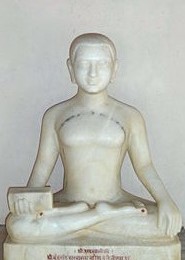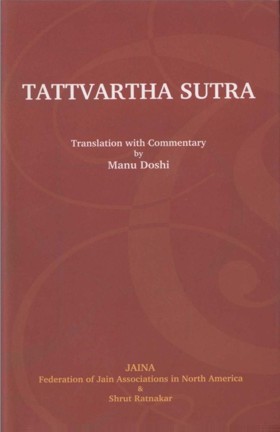05.07 Asankhyeyāh Pradeshā Dharmādharmayoh
Audio: Sanskrit: असङ्खयेया: प्रदेशा धर्माधर्मयो: ।
Hindi: धर्म और अधर्म के प्रदेश असंख्यात है।
05.08 Jeevasya cha
Audio: Sanskrit: जीवस्य ।
Hindi: एक जीव के प्रदेश असंख्यात है।
05.09 Ākāshasyānantāh
Audio: Sanskrit: आकाशस्यानन्ता: ।
Hindi: आकाश के प्रदेश अनन्त है।
05.10 Sankhyeyāsankhyeyashcha Pudgalānām
Audio: Sanskrit: सङ्खयेयाsसङ्खयेयाश्च पुद्गलानाम् ।
Hindi: पुद्गल द्रव्य के प्रदेश संख्यात, असंख्याय और अनन्त है।
05.11 Nānoh
Audio: Sanskrit: नाणो: ।
Hindi: अणु (परमाणु) के प्रदेश नहीं होते।
05.07-11
English: These sutras deal with the size of different substances. Their sizes are defined in terms of Pradesh, which has an exclusively Jain connotation. The objects that we see or know otherwise are generally divisible. They can be divided and subdivided till we reach a stage beyond which it is not possible to divide. Till the earlier part of the last century, the scientists believed that atom bore such a state and was considered indivisible. But the atom was split during the middle of that century and then it was noticed that it comprises proton, neutron and electron. Those sub-atomic particles are now considered indivisible.
Jainism conceives of a state of Paramānu, which is the finest part of Pudgal and is considered much more finer than a sub-atomic particle. That is indivisible and the area that one Paramānu occupies is known as Pradesh. Paramānus can, however, be bound together and binding of two or more Paramānus is termed as Skandha. A Skandha may thus consist of 2, 3, 4 H n. Paramānus. Such Skandhas can stay within one or more Pradeshas depending upon the kind of Paramānus of which they are composed.
The size of an object can therefore be specified in terms of the number of Pradeshas it occupies. However, the size of every object cannot be laid in numerical terms. There are substances, whose sizes are too big to be described by any known number. Those sizes are termed as consisting of innumerable Pradeshas. That term gives some idea of the size of the object concerned. Moreover, the size of Ākāsh cannot be described even by the term 'innumerable', because its size is endless. Thus we have to use three terms: numerable, innumerable and endless. In the description below, where the size can be laid in numerical figures, it is termed as Sankhyāt (numerable); where it is beyond any conceivable number, it is termed as Asankhyāt (innumerable); while if it is endless, it is termed as Anant.
These sutras state that every Jeev as well as Dharma and Adharma occupies innumerable Pradeshas, Akāsh occupies the endless number of Pradeshas; while a Skandha can occupy numerable or innumerable Pradeshas depending upon its composition. All of them, except Ākāsh, stay within Ākāsh, while Ākāsh stays by itself. In other words, it does not need any other substance to hold it.
In terms of size, Pudgal forms a class by itself. From the definition of Pradesh, it would be obvious that the size of one Paramānu is equal to one Pradesh. But a Paramānu is too subtle to be comprehended. We have therefore to think in terms of Skandhas. As explained above, a Skandha can consist of 2, 3, 4 H n Paramānus. Moreover, its Paramānus can be separated and other Paramānus can be combined with it. As such, the size of Skandha is variable.
Here we need to introduce the term Astikāy, which means the aggregate of more than one. Pradesh. It would be seen from the above description that size of Dharma, Adharma, Akāsh and of every Jeev and Skandha consists of many Pradeshas. As such, they are termed as Dharmāstikāy, Adharmāstikāy, Ākāshāstikāy, Jivāstikāy and Pudgālāstikāy. Since the terms Dharma and Adharma are mostly understood in different sense, we shall instead use Dharmāstikāy and Adharmāstikāy in this discussion.
Kāl (time) is also a substance, which is going to be introduced later. The smallest part of Kāl is Samay, which is equivalent to one Pradesh. As such there is no term like Kālāstikāy. There are thus five Astikayas, which are collectively known as Panchāstikāy.
 Acharya Umaswati
Acharya Umaswati
